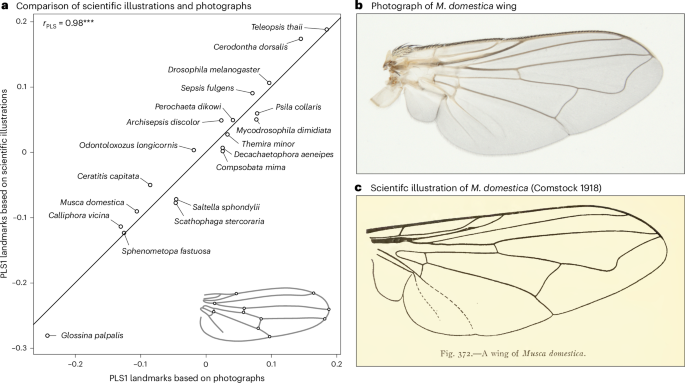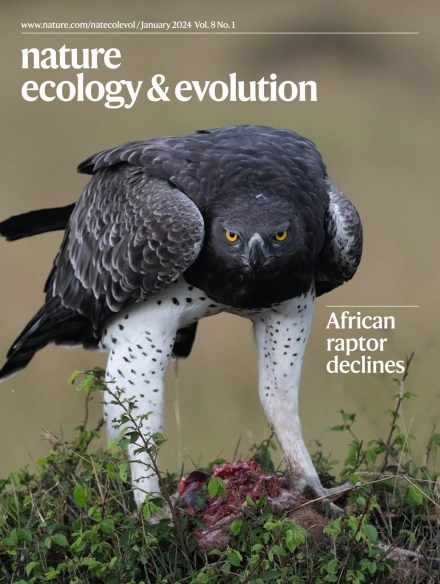Macroevolution along developmental lines of least resistance in fly wings
IF 13.9
1区 生物学
Q1 ECOLOGY
引用次数: 0
Abstract
Evolutionary change requires genetic variation, and a reigning paradigm in biology is that rates of microevolution can be predicted from estimates of available genetic variation within populations. However, the accuracy of such predictions should decay on longer evolutionary timescales, as the influence of genetic constraints diminishes. Here we show that intrinsic developmental variability and standing genetic variation in wing shape in two distantly related flies, Drosophila melanogaster and Sepsis punctum, are aligned and predict deep divergence in the dipteran phylogeny, spanning >900 taxa and 185 million years. This alignment cannot be easily explained by constraint hypotheses unless most of the quantified standing genetic variation is associated with deleterious side effects and is effectively unusable for evolution. However, phenotyping of 71 genetic lines of S. punctum revealed no covariation between wing shape and fitness, lending no support to this hypothesis. We also find little evidence for genetic constraints on the pace of wing shape evolution along the dipteran phylogeny. Instead, correlational selection related to allometric scaling, simultaneously shaping developmental variability and deep divergence in fly wings, emerges as a potential explanation for the observed alignment. This suggests that pervasive natural selection has the potential to shape developmental architectures of some morphological characters such that their intrinsic variability predicts their long-term evolution. Analysing wing shapes within and across distantly related dipteran lineages, the authors show that intrapopulation variation reflecting microevolutionary change can predict deep divergence at macroevolutionary timescales spanning 185 million years, and suggest that this pattern can be explained by correlational selection related to allometric scaling.


苍蝇翅膀沿最小阻力发育路线的宏观进化
进化变化需要遗传变异,生物学中的一个主流范式是,微进化的速度可以通过对种群内可用遗传变异的估计来预测。然而,随着遗传约束的影响减弱,这种预测的准确性在更长的进化时间尺度上应该会下降。本研究表明,两种远亲果蝇——黑腹果蝇(Drosophila melanogaster)和脓毒症(Sepsis punctum)——在翅膀形状上的内在发育变异性和长期遗传变异是一致的,并预测了跨越900个分类群、1.85亿年的双翅目系统发育的深度分化。除非大多数被量化的遗传变异与有害的副作用有关,并且有效地不能用于进化,否则这种一致性不容易用约束假设来解释。然而,对71个斑胸草遗传系的表型分析显示,翅膀形状与适合度之间没有共变,不支持这一假设。我们也发现很少有证据表明沿双翅类系统发育的翅膀形状进化速度的遗传限制。相反,与异速缩放相关的相关选择,同时塑造了苍蝇翅膀的发育变异性和深度分化,作为观察到的排列的潜在解释。这表明普遍的自然选择有可能塑造一些形态特征的发育结构,从而使它们的内在变异性预测它们的长期进化。
本文章由计算机程序翻译,如有差异,请以英文原文为准。
求助全文
约1分钟内获得全文
求助全文
来源期刊

Nature ecology & evolution
Agricultural and Biological Sciences-Ecology, Evolution, Behavior and Systematics
CiteScore
22.20
自引率
2.40%
发文量
282
期刊介绍:
Nature Ecology & Evolution is interested in the full spectrum of ecological and evolutionary biology, encompassing approaches at the molecular, organismal, population, community and ecosystem levels, as well as relevant parts of the social sciences. Nature Ecology & Evolution provides a place where all researchers and policymakers interested in all aspects of life's diversity can come together to learn about the most accomplished and significant advances in the field and to discuss topical issues. An online-only monthly journal, our broad scope ensures that the research published reaches the widest possible audience of scientists.
 求助内容:
求助内容: 应助结果提醒方式:
应助结果提醒方式:


